#translated to Middle Ages Europe
Text

#artists on tumblr#ai artwork#dark fantasy#“Feeding the Hungry Ghosts”#Chinese folklore#translated to Middle Ages Europe
22 notes
·
View notes
Text
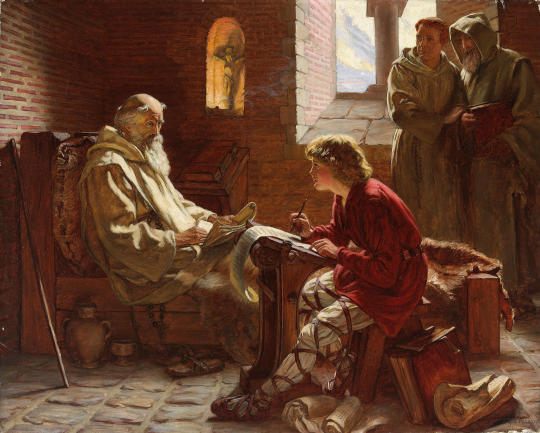
The Last Chapter by James Doyle Penrose
#bede#art#james doyle penrose#saint bede#the venerable bede#venerable bede#bede the venerable#deathbed#gospel of st john#medieval#middle ages#england#english#anglo saxon#anglo saxons#christianity#christian#monk#monks#religion#religious art#bible#writing#translator#translation#translating#history#europe#mediaeval#great britain
95 notes
·
View notes
Text
The missing Arthurian knight - rediscovered in 2019
Well the title is a slight lie - the missing knight wasn't rediscovered in 2019, it was earlier than that, but he didn't became public until 2019.
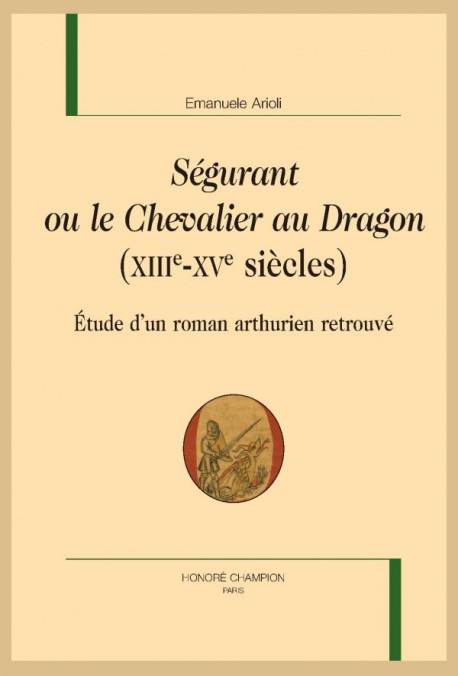
So what's this "missing knight" about? Well as the title says. There was a knight part of the Arthurian myth, and he had been missing ever since the Middle-Ages, and he was only recently rediscovered.
Or rather, to be exact - there was an Arthurian novel centered around a knight that existed and was a famous and well-known part of the Arthurian literature in the Middle-Ages, but that completely disappeared, and was forgotten by culture (as much popular culture as the scholarly one). Until very recently.
This rediscovered novel has been a hot topic of all Arthuriana fans in Europe for a few years now - and yet I do not see much talk about this onto this website, despite Tumblr being a big place for Arthurian fans?
So I will correct this by doing a series of posts about the subject. And this post will be the first one, the introduction post presenting to you "Ségurant, le chevalier au dragon" ; "Segurant, the knight of the dragon". A French medieval novel part of the Arthurian literature (hence the "chevalier au X" title structure - like Lancelot, the knight of the cart or Yvain the knight of the lion from Chrétien de Troyes), the reason this story was forgotten by all medievalist and literary scholars is - long story short - because it never existed in any full manuscript (at least none that survived to this day). It was a complete story yes, with even variations apparently, but that was cut into pieces and fragments inserted into various other manuscripts and texts (most notably various "Merlin's Prophecies").
The novel and the Knight of the Dragon were rediscovered through the work of Emanuele Arioli, who rediscovered a fragment of the story while looking at an old manuscript of a Merlin Prophecies, and then went on the hunt for the other fragments and pieces scattered around Europe, until he finally could compile the full story, that he then published in 2019, at the Belles Lettres publishing house, in 2019.
Arioli reconstructed the text, and translated it in both modern French and Italian for scholarly and professional editions (aka Honoré Champion in France, a reference for universities)...
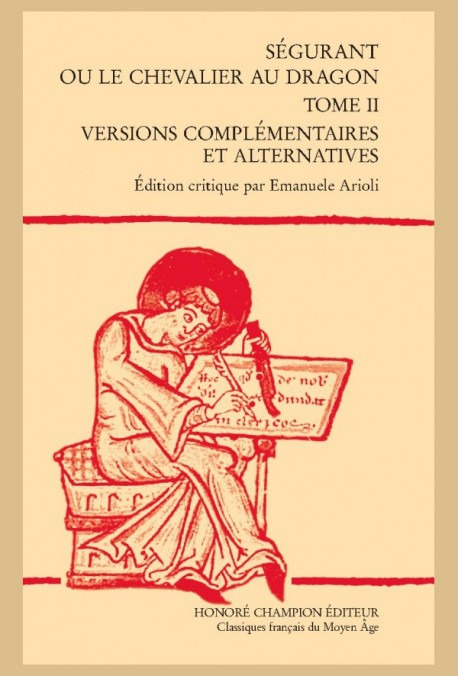
... But also for a more "all public, found in all libraries" edition - the famous 2019 edition at Les Belles Lettres.

And not only that, but he also participated to both a comic book adaptation with Emiliano Tanzillo...
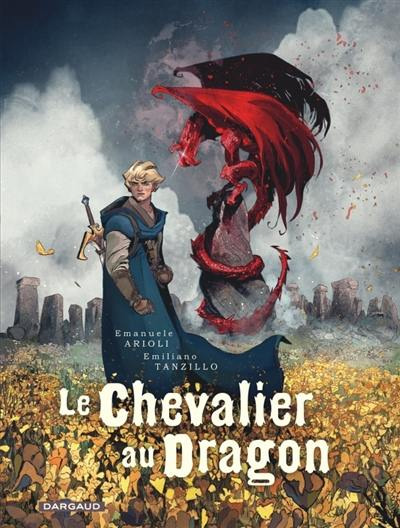
... and an adaptation as an illustrated children novel!

Finally, just a few weeks, the Franco-German channel Arte released a documentary about the reconstitution and content of this missing novel called "Le Chevalier au dragon: Le roman disparu de la Table Ronde". (The Knight of the Dragon - The missing novel of the Round Table). The full documentary is on Youtube in French for those that speak the language, here. And in German here for those who speak German.
Unfortunately there is no English version of the documentary that I know of, nor any English publications of the actual text - just French and Italian. But hey, I'll try to palliate to that by doing some English-speaking posts about this whole business!

#ségurant#segurant#the knight of the dragon#le chevalier au dragon#arthuriana#arthurian myth#arthurian literature#arthurian novel#discoveries#medieval literature#arthurian legend#arthurian knights#found media#lost media#that people didn't even know was lost
312 notes
·
View notes
Photo
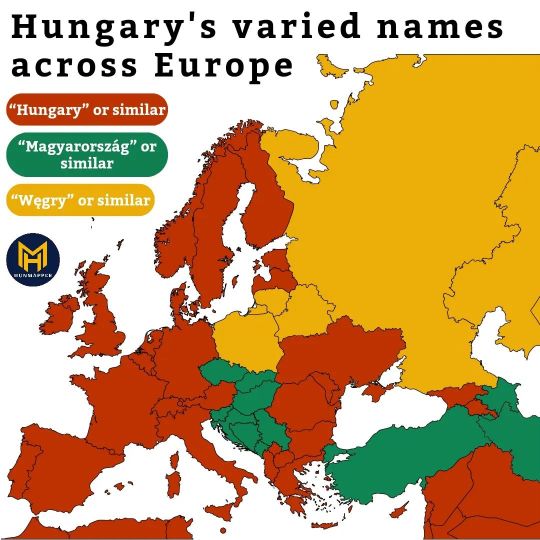
Hungary's varied names across Europe
by hunmapper
Hungary: The English word "Hungary" is derived from the Medieval Latin term "Hungaria," which originally came from the Old Church Slavonic word "Ǫgǫry" or "Ǫgǫri," referring to the people living to the southeast of the Germanic tribes. The root of this word might be related to the Huns, who were a nomadic people in the region during the early Middle Ages.
Magyarország: In Hungarian, the official language of Hungary, the country is referred to as "Magyarország." This term is a combination of "Magyar," which is the ethnic group of the Hungarian people, and "ország," meaning "country" or "land." Therefore, "Magyarország" translates to "Land of the Magyars" or "Country of the Hungarians."
Węgry: The term "Węgry" is the Polish name for Hungary. It has its roots in the medieval Slavic term "Ugric," which originally referred to the Ugric people, an ancient ethnic group that included the Magyars. Over time, the term evolved, and in Polish, it became "Węgry."
153 notes
·
View notes
Text
European history is not white


Someone commented this to a post I reblogged, which message is basically "we shouldn't venerate the Dead White Man HistoryTM and we should elevate other history too, but we still need to learn Dead White Man HistoryTM to understand the world today". It's basically a response to the attitude you sometimes come across in the internet that sees learning about those Dead White MenTM as not worth our time. And this person, who seems to be following this blog because they responded to my reblog, takes it as a personal attack against all white Europeans. For some reason. Well I take these comments as a personal attack against historical understanding.
Firstly, the post clearly didn't say you shouldn't venerate any European history, because not all European history is Dead White Man HistoryTM. Obviously this person thinks European history is white, which is not true, but surely, surely, they know it's not all men? Secondly, what is "west culture"? When did it start? There is not one western culture, not one European culture. The first concept of some shared Europeanness was the Christendom in Middle Ages, but it was not exactly the same as we think of Europe today, because it did not include the pagan areas, but it included a lot of Levant and parts of Central Asia, where there were large Christian areas. And Europe was not "very white" nor was the Christendom. The more modern concept of West was cooked in tandem with race and whiteness during colonial era and Enlightenment, around 17th to 18th centuries. And Europe was certainly not very white then. The western world also includes a lot of colonized areas, so that's obviously not white history. Thirdly, implying that asking white people to apologize for European history (which no one did ask) is as ridiculous as asking black people for African history is... a choice. Black people do exist in a lot of other places than Africa, which white people should be the ones apologizing for, and really white people also have a lot to answer for about African history. Lastly, if you think the quote "anyone who thinks those dead white guys are aspirational is a white supremacist" means you as an European are demanded to apologize for your existence, maybe - as we say in Finland - that dog yelps, which the stick clanks. (I'm sorry I think I'm the funniest person in the world when I poorly translate Finnish sayings into English.)
The thing is, there is no point in European history, when Europe was white, for three reasons. 1) Whiteness was invented in 17th century and is an arbitrary concept that has changed it's meaning through time. 2) Whichever standard you use, historical or current, Europe still has never been all or overwhelmingly white, because whiteness is defined as the in-group of colonialists, and there has always been the internal Other too. In fact the racial hierarchy requires an internal Other. 3) People have always moved around a lot. The Eurasian steppe and the Mediterranean Sea have always been very important routes of migration and trade. I've been meaning to make a post proving exactly that to people like this, since as I've gathered my collection of primary images of clothing, I've also gathered quite a lot of European primary images showing non-white people, so I will use this opportunity to write that post.
So let's start from the beginning. Were the original inhabitants of Europe white? Of course not. The original humans had dark skin so obviously first Europeans had dark skin. Whenever new DNA evidence of dark skinned early Europeans come out (like this study), the inevitable right-wing backlash that follows is so interesting to me. Like what did you think? Do you still believe the racist 17th century theories that white people and people of colour are literally different species? I'm sure these people will implode when they learn that studies (e.g. this) suggest in fact only 10 000 years ago Europeans had dark skin, and even just 5 000 years ago, when Egypt (an many others) was already doing it's civilization thing, Europeans had brown skin (another source). According to the widely accepted theory, around that time 5 000 years ago the Proto-Indo-European language developed in the Pontic-Caspian steppe, which extends from Eastern Europe to Central Asia. These Proto-Indo-Europeans first migrated to Anatolia and then to Europe and Asia. Were they white? Well, they were probably not light skinned (probably had brown skin like the other people living in Europe around that time), the Asian branch of Indo-European peoples (Persians, most Afghans, Bengalis, most Indians, etc.) are certainly not considered white today and a lot of the people today living in that area are Turkic and Mongolic people, who are also not considered white. I think this highlights how nonsensical the concept of race is, but I don't think Proto-Indo-Europeans would have been considered white with any standard.
Around Bronze Age light skin became common among the people in Europe, while in East Asia it had become wide spread earlier. This does not however mark the point when "Europe became white". During the Bronze Age there was a lot of migration back and forth in the Eurasian steppe, and the early civilizations around Mediterranean did a lot of trade between Europe, Africa and Asia, which always means also people settling in different places to establish trading posts and intermarrying. There were several imperial powers that also stretched to multiple continents, like the briefly lived Macedonian Empire that stretched from Greece to Himalayas and Phoenicians from Levant, who didn't built an empire but settled in North Africa, Sicily and Iberia. In Iron Age the Carthaginian Empire, descendants of Phoenician settlers in current Tunisia, build an Empire that spanned most of the western Mediterranean coast. Their army occupying that area included among others Italic people, Gauls, Britons, Greeks and Amazigh people.
Iron Age also of course saw the rise of the Roman Republic, and later empire, but it was preceded by Etruscans, who populated Tuscan, and possibly preceded the Indo-European presence. However, weather through trade and migration with other Mediterraneans or the continuing presence of darker skin tones of the early Europeans, their art quite often depicts darker skin tones too, like seen below in first two images. Roman Empire at it's height spanned from Babylonia to the British Isles. They recruited soldiers from all provinces and intentionally used stationed them in different areas so they wouldn't be too sympathetic to possible rebels or neighboring enemies. Historical sources mention black Nubian soldiers in British Isles for example. They also built a lot of infrastructure around the empire to ensure protection and easy transportation through trade routes inside the empire. During this time Jewish groups also migrated from Levant to both North-Africa and Europe. Rome even had non-European emperors, like Septimius Severus who originated from Levant and was Punic (descendants of Phoenicians) from his father's side, and who was depicted with darker skin (third picture below). Various ethnicities with differing skin tones are represented all over Roman art, like in the fourth picture below from hunting lodge in Sicily.

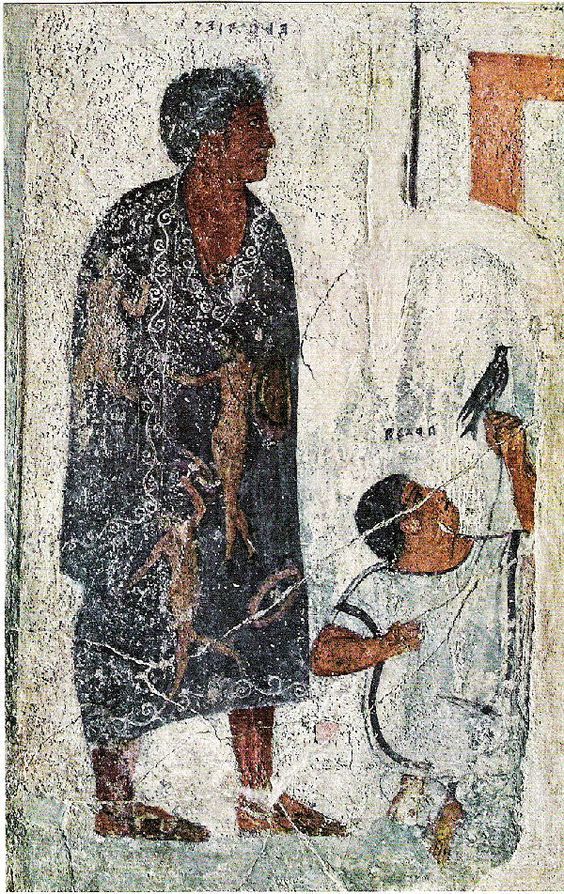


Eurasian steppe continued to be important source of migration and trade between Europe and Asia. Scythians, Iranic nomadic people, were important for facilitating the trade between East Asia and Europe through the silk road during the Iron Age. They controlled large parts of Eastern Europe ruling over Slavic people and later assimilating to the various Slavic groups after loosing their political standing. Other Iranic steppe nomads, connected to Scythian culture also populated the Eurasian steppe during and after Scythia. During the Migration Period, which happened around and after the time of Western Rome, even more different groups migrated to Europe through the steppe. Huns arrived from east to the Volga region by mid-4th century, and they likely came from the eastern parts of the steppe from Mongolian area. Their origins are unclear and they were either Mongolic, Turkic or Iranic origin, possibly some mix of them. Primary descriptions of them suggests facial features common in East Asia. They were possibly the nomadic steppe people known as Xiongnu in China, which was significant in East and Central Asia from 3rd century BCE to 2nd century CE until they moved towards west. Between 4th and 6th centuries they dominated Eastern and Central Europe and raided Roman Empire contributing to the fall of Western Rome.
After disintegration of the Hun Empire, the Huns assimilated likely to the Turkic arrivals of the second wave of the Migration Period. Turkic people originate likely in southern Siberia and in later Migration period they controlled much of the Eurasian steppe and migrated to Eastern Europe too. A Turkic Avar Khagenate (nation led by a khan) controlled much of Eastern Europe from 6th to 8th century until they were assimilated to the conquering Franks and Bulgars (another Turkic people). The Bulgars established the Bulgarian Empire, which lasted from 7th to 11th in the Balkans. The Bulgars eventually adopted the language and culture of the local Southern Slavic people. The second wave of Migration Period also saw the Moor conquest of Iberia and Sicily. Moors were not a single ethnic group but Arab and various Amazigh Muslims. Their presence in the Iberian peninsula lasted from 8th to 15th century and they controlled Sicily from 9th to 11th century until the Norman conquest. During the Norman rule though, the various religious and ethnic groups (which also included Greeks and Italic people) continued to live in relative harmony and the North-African Muslim presence continued till 13th century. Let's be clear that the Northern Europe was also not white. Vikings also got their hands into the second wave migration action and traveled widely to east and west. Viking crews were not exclusively Scandinavians, but recruited along their travels various other people, as DNA evidence proves. They also traded with Byzantium (when they weren't raiding it) and Turkic people, intermarried and bought slaves, some of which were not white or European. A Muslim traveler even wrote one of the most important accounts of Vikings when encountering them in Volga.
By this point it should already be clear that Medieval Europe was neither white, but there's more. Romani people, who originate from India and speak Indo-Aryan language, arrived around 12th century to Balkans. They continued to migrate through Europe, by 14th century they were in Italy, by 15th century in Germany and by 16h century in Britain and Sweden. Another wave of Romani migration from Persia through North-Africa, arrived in Europe around 15th century. Then there's the Mongol Empire. In 13th century they ruled very briefly a massive portion of the whole Eurasian continent, including the Eastern Europe. After reaching it's largest extent, it quickly disintegrated. The Eurasian Steppe became the Golden Horde, but lost most of the Eastern-Europe, except Pontic-Caspian Steppe. They ruled over Slavs, Circissians, Turkic groups and Finno-Ugric groups till early 15th century. The Mongolian rulers assimilated to the Turkic people, who had been the previous rulers in most of the steppe. These Turkic people of the Golden Horde came to be known as Tatars. Golden Horde eventually split into several Tatar khagenates in 15th century, when the khagenates, except the Crimean Khagenate, were conquered by the Tsardom of Moscovy. Crimean Khagenate was annexed by the Russian Empire in 1783. Crusades were a movement from Europe to Levant, but they also meant intermarriage in the the Crusader kingdoms especially between the European and Levant Christians, and some movement back and froth between these kingdoms and Europe, trade and a lot of movement back after the Crusader kingdoms were defeated in 13th century. Generally too trade across the Mediterranean sea was extensive and led to migration and intermarriage.
And here's some example of people of colour in Medieval European art, shown as part of the majority white European societies. First is from a 15th century French manuscript depicting Burgundy court with dark skin courtier and lady in waiting. Second one is from a Flemish manuscript from 15th century of courtiers, including a black courtier, going for a hunt. Third is a 15th century Venetian gondolier with dark skin.

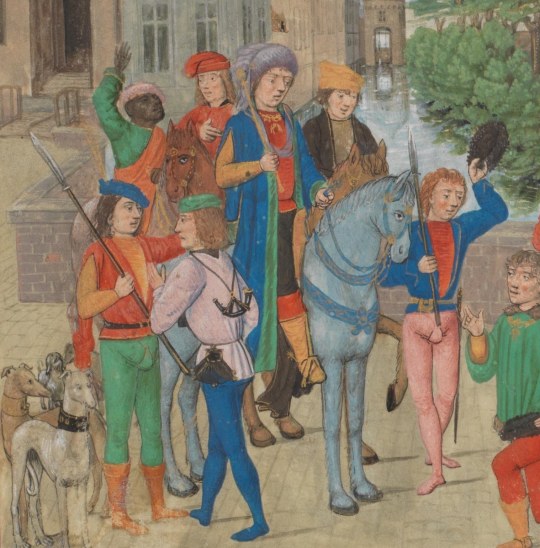

In Renaissance Era Europe was only increasing it's trade and therefore had even more connections outside Europe. The first picture below is Lisbon, which had strong trade relationship with Africa, depicted in late 16th century. People with darker skin tones were part all classes. Second image is an Italian portrait of probably a seamstress from 16th century. Third one is a portrait of one of the personal guards of the Holy Roman Emperor. Fourth image is a portrait of Alessandro de' Medici, duke of Florence, who was noted for his brown complexion, and the modern scholarly theory is that his mother was a (likely brown) Italian peasant woman.
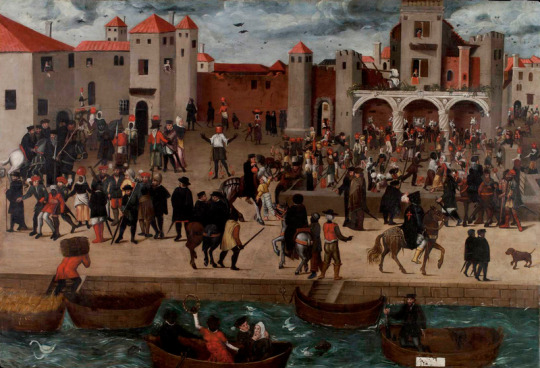

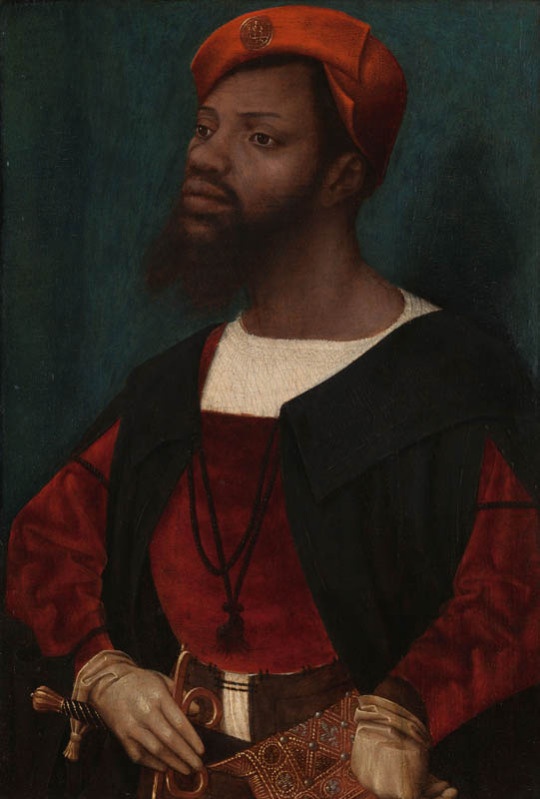

Colonialism begun in the Renaissance Era, but the wide spread colonial extraction and slavery really got going in the 17th century. Racial hierarchy was developed initially to justify the trans-Atlantic slave trade specifically. That's why the early racial essentialism was mostly focused on establishing differences between white Europeans and black Africans. Whiteness was the default, many theories believed humans were originally white and non-whites "degenerated" either through their lives (some believed dark skin was basically a tan or a desease and that everyone was born white) or through history. Originally white people included West-Asians, some Central-Asians, some North-Africans and even sometimes Indigenous Americans in addition to Europeans. The category of white inevitably shrank as more justifications for atrocities of the ever expanding colonial exploitation were required. The colonial exploitation facilitated development of capitalism and the industrial revolution, which led to extreme class inequality and worsening poverty in the European colonial powers. This eventually became an issue for the beneficiaries of colonialism as worker movements and socialism were suddenly very appealing to the working class.
So what did the ruling classes do? Shrink whiteness and give white working classes and middle classes justifications to oppress others. Jews and Roma people had long been common scapegoats and targets of oppression. Their oppression was updated to the modern era and racial categories were built for that purpose. The colonial powers had practiced in their own neighborhoods before starting their colonial projects in earnest and many of those European proto-colonies were developed to the modern colonial model and justified the same way. In 19th century, when racial pseudoscience was reaching it's peak, Slavs, others in Balkan, the Irish (more broadly Celts), Sámi (who had lost their white card very early), Finns, Southern Italians, the Spanish, the Southern French and Greeks all were considered at least not fully white. The Southern Europeans and many Slavs were not even colonized (at least in the modern sense, though with some cases like Greeks it's more complicated than that), but they looked too much and were culturally too similar to other non-white Mediterraneans, and they were generally quite poor. In many of these cases, like Italians, the French and Slavs, it was primarily others belonging in the same group, who were making them into second class citizens. All this is to highlight how very malleable the concept of race is and that it's not at all easy to define the race of historical people.
However, even if we would go with the racial categories of today, Europe was still far from being all white in this period. You had Roma, who certainly are not included in whiteness today, and European Jews, whose whiteness is very conditional, descendants of Moors in Southern Europe and Tatars and Turks in Eastern Europe and Turkey, which today is often not thought of as part of Europe, but historically certainly was. And then colonialism brought even more people into Europe forcibly, in search of work because their home was destroyed or for diplomatic and business reasons. There were then even more people of colour, but they were more segregated from the white society. Black slaves and servants are very much represented in European art from 17th century onward, but these were not the only roles non-white people in Europe were in, which I will use these examples to show. First is a Flemish portrait of Congo's Emissary, Dom Miguel de Castro, 1643. Second is a 1650 portrait of a Moorish Spanish man Juan de Pareja, who was enslaved by the artist as artisanal assistant, but was freed and became a successful artist himself. Third is a 1768 portrait of Ignatius Sancho, a British-African writer and abolitionist, who had escaped slavery as a 20-year-old. Fourth painting is from 1778 of Dido Elizabeth Belle, a British gentlewoman born to a slave mother who was recognized as a legitimate daughter by her father, and her cousin. The fifth portrait is of an unknown woman by (probably) a Swiss painter from late 18th century. Sixth is a 1760s Italian portrait of a young black man.

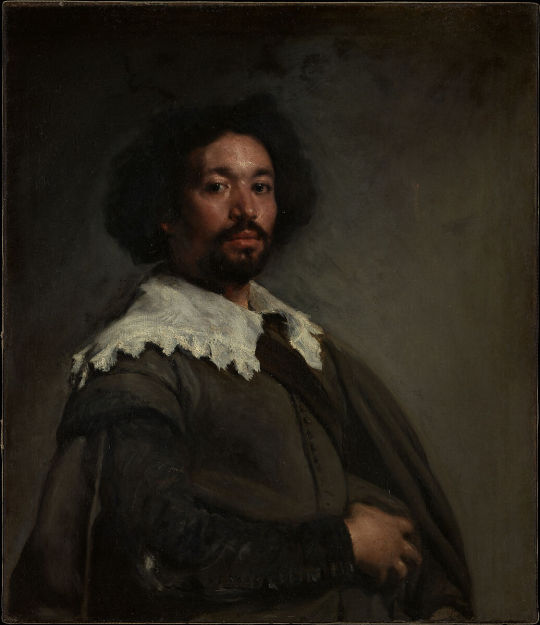
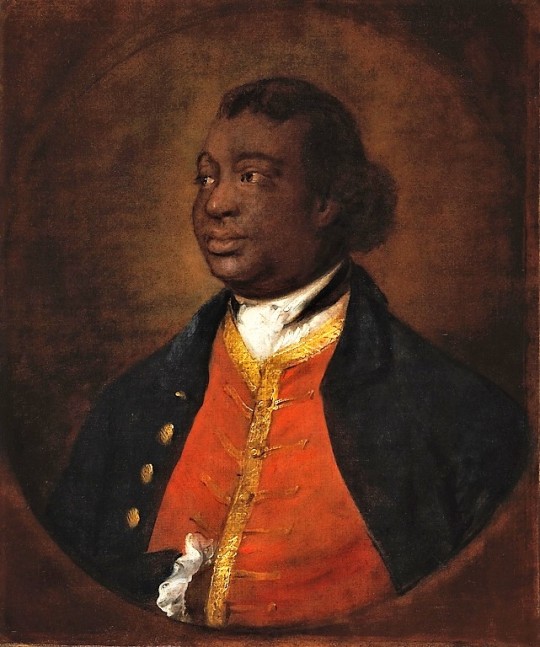
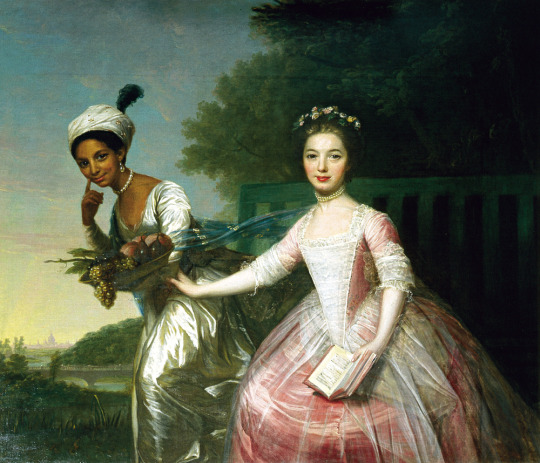
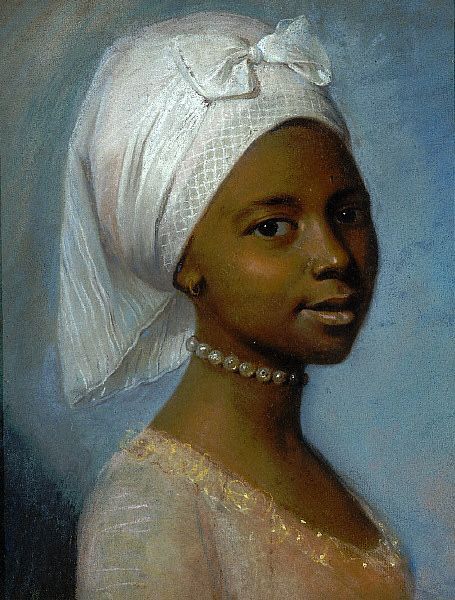
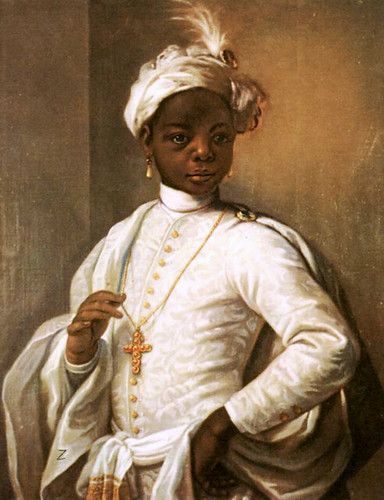
In late 18th century England abolished slavery in British Isles first, then in early 19th century in the whole British Empire, thanks to the continuous campaign of free Black people and some white allies, notably Quakers. Around the same time slavery was abolished in France (briefly till Napoleon got to power) after the French revolution. This meant there were a lot more free black people in Europe after that. In 18th century the Europeans, British especially, were colonizing Asia as much they could, which meant that in 19th century there started to also be a lot more Asian, especially Indian people in Europe. First picture below is of Thomas Alexander Dumas, who was son of a black slave woman and a white noble French man and became a general in the French revolutionary army. His son was one of the most well-known French authors, Alexander Dumas, who wrote The Count of Monte Cristo and The Three Musketeers. Second portrait is of Jean-Baptiste Belley, a Senegalese former slave, who became French revolutionary politician. Third portrait is from 1810 of Dean Mahomed, an Indian-British entrepreneur, who established the first Indian restaurant in London. Forth is Arab-Javanese Romantic painter Saleh Syarif Bustaman, who spend years in Europe. Fifth is a 1862 photo of Sara Forbes Bonnetta, originally named Aina, princess of Edbago clan of Yoruba, who was captured into slavery as a child, but later freed and made Queen Victoria's ward and goddaughter. She married a Nigerian businessman, naval officer and statesman, James Pinson Labulo Davies (sixth picture).
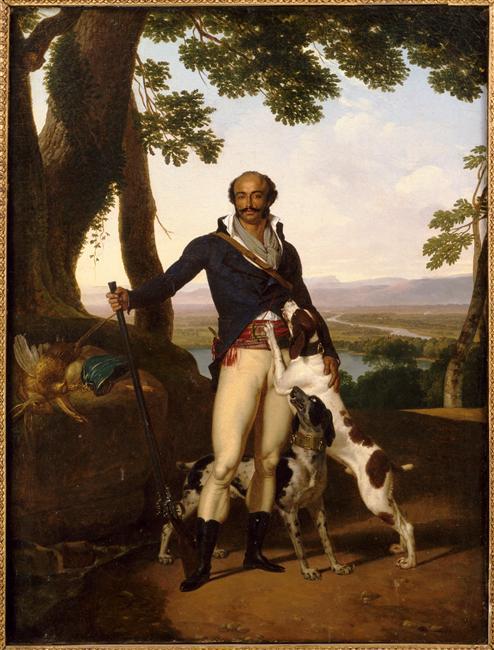


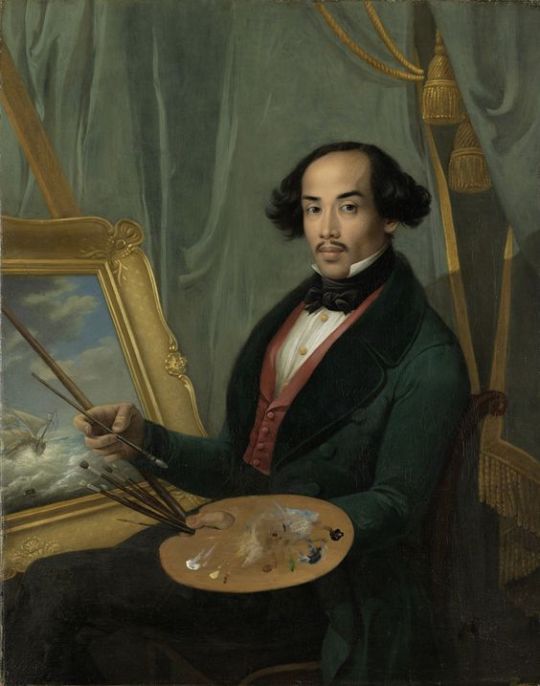
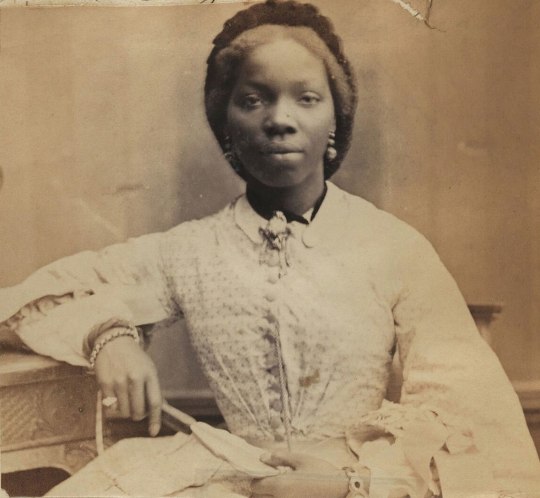
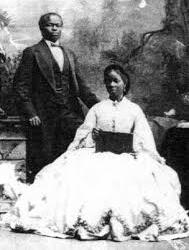
So any guesses on at what point was that "very white Europe" when the "west culture" begun? It kinda seems to me that it never actually existed.
#history#poc history#black history#historical art#european history#history of race#colonialism#racism#slavery#painting#photograph
174 notes
·
View notes
Text
'TIL a papyrus scroll indicates that, during the building of the tomb of Pharaoh Ramses III, the workers were upset about their treatment and, rather than discussing it with them, management served them a large meal.
'The workers didn't think that was enough so occupied the Valley of the Kings refusing entry to anyone until they were given a raise and "cosmetics" (research shows it was a form of sunscreen).
'So not only does workers organizing a strike and forming a picket line for better wages and workplace safety conditions date back TO THE FRIGGIN' BRONZE AGE, but also management has been trying to placate discontented workers with a pizza party.'
And then that went viral on Twitter and I got hammered with people trying to "Well ackshually" about my three-tweet-long thread on a thing I'd learned just that morning I turned into a joke about corporate pizza parties. So I decided to research and here's the entire story.
TL;DR: I was pretty much right except it'd be closer to say "donuts/cupcakes in the breakroom" rather than "pizza party".
The events took place sometime around 1157 BCE (specifically the 29th year of Ramses III’s reign) in the village of Deir el-Medina, a worker village for the people who worked on the built the tombs in the Valley of the Kings.
BTW, the site itself is fascinating as it was first excavated in 1922 and ended up being one of the most thoroughly documented accounts of community life in the ancient world and proved the builders of the Pyramids were middle-class skilled artisans and craftspeople, not slaves.
You also have to know that this era of history is around the start of what’s known as the Bronze Age Collapse. Some sort of environmental catastrophe happened that caused widespread crop failures across the ancient world.
Now what precisely happened is strongly debated, but generally several groups from elsewhere in Europe and Africa known as the “Sea People” attacked the ancient civilizations of the Mediterranean, which caused most of those cultures to collapse.
Also, commerce was a bit different as they were (oversimplified explanation) on the bread standard. Salaries were measured in values of beer and bread as the recipes for those were standardized and made up the basics of the diet.
So while common laborers would be paid in literal beer and bread, more highly-valued workers would be paid in an equivalent of a larger allotment of beer and bread. So they’d get paid “100 loaves a day” worth of oil or metal or coin representing the value.
Now, for our tale. This comes from the contemporary account of the scribe Amennakhte. If anyone wants to read along, a photo of the scroll along with a translation is available to read for free at https://libcom.org/article/records-strike-egypt-under-ramses-iii-c1157bce
On Year 29, Second Month of Winter, Day 10, a group of workers walked past the guards and sat at the Temple of Menkheperre stating it had been 18 days since they’d last been paid, staying the night in the tomb saying “We have matters of Pharaoh”.
The following day, a scribe brought the workers 55 “s'b-cakes”. So yes, a “pizza party”. I can’t find any reference to what this is precisely other than “fine bread” that was worth more than a large loaf of standard bread.
Seriously, I wasted an hour of my life trying to figure out what “s'b-cakes” are exactly so if anyone knows please tell me.
Anyway, it didn’t work and there was “quarrelling” at the temple of Ramses II. The translations says “chief of police” which doesn’t seem quite right but I’ll go with it, but anyway he said he’d fetch the mayor of Thebes.
The mayor claimed they didn’t have enough to pay. The workers responded by saying “The prospect of hunger and thirst has driven us to this. There is no clothing, there is no ointment*, there is no fish, there are no vegetables.”
They then said to go tell it to the Pharoah directly. On Day 12 (the day following the “quarrelling”), they were given their ration they were due during the previous month (basically, they got their back pay). It was 21 days late.
Side note: I got some pushback by an “Egyptologist” for calling the “ointment” a type of sunscreen and…yes, it was. Some translations mark this as “cosmetics” but it was a medicinal balm used to prevent and treat sunburn. What the hell else would you call it?
So Day 13 (the fourth day of the strikes) and Mentmose, the “chief of police”, apparently took a side. He told the workers to lock down the work site and continue their protests, and that he’d lead them to the temple to continue the sit in.
His words (recorded by Amennakhte): “I’ll tell you my opinion. Go up, gather your tools, close your doors, fetch your families, and I’ll lead you to the temple of Seti I and let you settle down there.”
At this point, the tax master Ptahemheb came out to talk to them making a list of all the things they demanded. On Day 15 (sixth day of the strike), they tried another “pizza party” with half a sack of barley and a jar of beer for each worker.
Amennakhte doesn’t say what their response was exactly, but does say that the workers brought torches so they could continue the protest in the dark. So I take it the response wasn’t good.
Day 17 (eighth day of the strike), the head of the temple came out and asked what demands to bring to the Pharoah for them. And they gave a detailed list of what precise wages they wanted for each of the workers.
On that day, they were given what they asked for in rations for the second month of winter. They may have also been paid early as they should have been paid on the 21st or 28th day depending on the source.
So we’re now in the third month of winter (no exact date written) and they’re still striking. Worker Mose said basically “As Amun as my witness if you drag me away I will come back and start robbing the tombs.” I couldn’t fit the whole thing in one tweet.
Reshpetref, the proctor, said “We will not come back, you can tell your superiors that. For sure, it is not because of hunger that we strike, but we have a serious charge to make. Something bad has been done in this place of the Pharoah”.
We’re on the fourth month of winter now, Day 28 (so over three months of striking now) before the Vizier shows up. This is the government official that handles day-to-day business and is second only to the Pharoah.
He says he just got promoted so isn’t authorized to give them their wages (at least partially true, he’d just been promoted five days prior) and even if he could, there was nothing in the granaries to pay them with.
The granaries may have been empty because of the other issues going on with the Bronze Age Collapse or it may have just been the rampant corruption speculated of the government of the era, or he may have been lying.
On the first month of summer Day 2, the crew got two sacks of grain as their ration (they’d demanded 5 ½ sacks each). The foreman Khonsu told them accept it, then go down to the market and tell the Vizier’s children about it.
Amennakhte (who again, is writing this scroll) stopped them and said NOT to go to the market since they’d been paid and if they did, he’d have to have them arrested. He doesn’t mention they were only paid a third of what they were owed.
First month of summer, Day 13, passes the guard post saying “We are hungry” and continued their sit in. They shouted at the mayor of Thebes as he passed, who then got them 50 sacks of grain to tide them over until Pharoah paid them.
That’s the end of this particular scroll, but there’s evidence that strikes continued throughout the reign of Ramses III as there are records of more workers being hired to transport food and supplies to the workers.
The scroll also leaves out some of what happened in between dates. For example, it wasn’t one single long strike, but a series of them. After they were paid their wages the first time, the workers went back to work.
However, they were told that was their pay for the third month of winter and not the second so they wouldn’t be getting paid again, sparking the second strike that lasted into summer.
There’s also a big deal in Egyptian culture at the time called “Ma’at” or basically “The Order of Things”. Nobody had any idea what to do with the striking workers because workers weren’t supposed to strike. They were supposed to work.
Sure, they were treated well and the village of Deir el-Medina lived at what could be called middle-class standards for the time period, but they weren’t supposed to rebel against their betters in this way. It was unthinkable.
There was also a big festival coming up to celebrate the 30th year of the reign of Ramses III and a lot of the government officials were focused on that, more concerned with maintaining order than actually managing the country.
I should also note I paint Amennakhte as on the side of the government rather than the workers when the opposite was likely the case. The strike wasn’t recorded in the official government records as Egypt tended to cover up their losses.
That said, we do have some records like those of Amennakhte showing that, once the workers realized they had the power to organize, they used it all the way through the New Kingdom.
The last entry on the scroll doesn’t directly involve the strike, but is related. On the first month of summer, Day 16, one of the workmen provided evidence that government officials were stealing from the tombs.
One of them, Weserhat, was one of the ministers who shorted the workers payment previously. The other, Pentaweret, may be the son of Ramses III at the center of the “Harem Conspiracy”, an assassination plot that took place between 1 to 3 years later.
In summary, the workers were unpaid due to corruption and management enriching themselves, they went on strike, management threw them a pizza party, that didn’t work, and they eventually got their demands.
Though I guess if you want to be completely accurate, it was more “donuts/cupcakes in the breakroom”…
#egypt#ramses iii#ramesses iii#labor rights#strike#pizza party#donuts in the breakroom#union#union strong#Also before anyone says this is Ramses III not the Pharaoh of Exodus#That was Ramses II almost a century earlier and a completely different dynasty#Not going to open the can of worms that is archeological evidence (or lack thereof) supporting biblical accounts of history#But either way the events are unrelated as they were 70-100 years after Exodus would have been#ancient egypt#ancient history
648 notes
·
View notes
Text
The Easter Bunny / Easter Hare
In German Easter tradition, the Easter Bunny is an imaginary rabbit or hare who paints eggs at Easter and hides them in the garden. Children search for Easter eggs on the morning of Easter Sunday. The motif of the Easter Bunny has recently spread in the popular culture of Easter, also through its commercial use, and has largely replaced earlier bringers of the Easter egg.

As far as is known, the Easter Bunny was first mentioned in the dissertation of the Frankfurt doctor Johannes Richier, who received his doctorate in 1682 under the respected Heidelberg professor of medicine Georg Franck von Franckenau with his treatise "De ovis paschalibus - von Oster-Eyern". The son of the pastor Jean Richier, who had fled France for religious reasons, describes a custom in Upper Germany, the Palatinate, Alsace and neighbouring regions, as well as Westphalia, according to which an Easter Bunny lays the eggs (ova excludere) and hides them in gardens in the grass, bushes, etc., where they are eagerly searched for by children amid laughter and to the amusement of the adults (cum risu et iucunditate seniorum). He calls the Easter Bunny hiding the eggs “a fable that is told to simpletons and children” (fabula, que simplicioribus et infantibus imponunt).
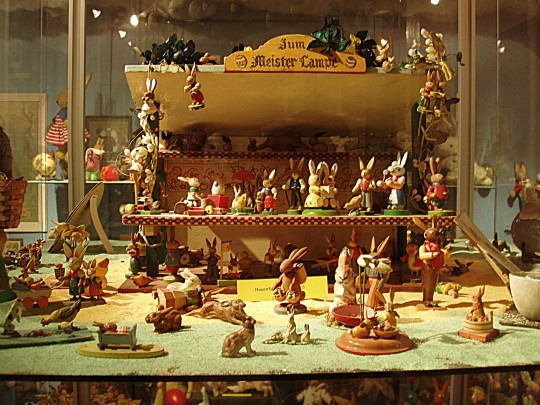
According to cultural studies, the reason for the strong upswing that belief in the Easter Bunny experienced in the 19th century can be found in the industrial production of cheap beet sugar, which made the production of affordable chocolate bunnies and eggs possible in the first place.

The connection between the Christian Easter festival and the egg as a symbol has been known in various European countries since the Middle Ages at the latest, and may even date back to earlier. There is also an older interpretation of the rabbit as a symbol of resurrection since Ambrose. The diverse Christian symbolism of the rabbit found expression in many works of art in the Middle Ages, see Rabbit in art. The connection between the rabbit and the Easter egg tradition is still unclear, however, even if the fertility of rabbits in itself has a close connection to spring. The following hypotheses are often put forward:
Some early painted Easter eggs show the three-hare image, a depiction of three hares with only three ears in total, but each hare having two ears due to the "double use" of ears; this is a well-known symbol for the Holy Trinity. It is possible that this depiction may have given rise to the idea of the hare as an egg supplier.
In one passage in the Bible, Psalm 104:18, older translations speak of "hares". The reason for this was the Latin translation of Proverbs 30:26, in which Jerome translated the Hebrew "schafan" (rock hyrax) as "lepusculus" (hare). Since late antiquity, this passage has been interpreted as a symbol for the weak human (hare) who seeks refuge in the rock (Christ). This interpretation established the symbolism of the hare in Christian iconography.
It is widely considered harmless to tell young children that the Easter Bunny brings eggs and sweets for Easter. Psychologists believe that this illusion stimulates the imagination and supports cognitive development. However, children's critical questions and doubts should be supported so that their belief in the Bunny eventually disappears by itself, also through interaction with other children.
The Easter Bunny was spread outside of Europe by German-speaking emigrants. It has gained a certain popularity in the USA in particular. In English, the term "Easter Bunny" predominates over the literal translation "Easter Hare", so the figure is often understood to be a rabbit.
In Australia, the "Easter Bilby" has been placed alongside the "Easter Bunny" since the 1970s. The aim is to draw attention to the endangered species of the greater burrowing bandicoot ("Bilby"), not least due to the spread of European rabbits, and to raise money for a conservation fund by selling chocolate bilbies.
138 notes
·
View notes
Text
Facts About Romani People Because That One Person Asked For it On My Post About Azusa
A while back I made a post about how I wished people in the Diabolik Lovers fandom focused more on how Azusa is a Romani man and how cool that was for an otome game. Somebody reblogged and asked for somebody to make a post about Romani people so we'd have more reference on how to incorporate Azusa's heritage into more content of him so here it is!
I wanna preface this post by saying that I am not Romani or of Romani descent! I simply like learning about other cultures and groups of people and want people to learn more information about a race that has been villainized and oppressed for centuries. While I'll be discussing basic history, myths and stereotypes, and basics in culture, please make sure you go find Romani creators and people to get more information from! I love Florian on TikTok and YouTube so I recommend checking him out first!
As somebody who is not Romani, there might be some things that aren't completely correct since I'm relying on what is available. Always listen to Romani voices when looking for information. I'm just providing basics and am definitely NOT and expert!
Basic Terminology & History
First off, you might know Romani people often being referred to as the G-word. It's a racial slur that came from people believing they originated in Egypt and has been used for centuries to degrade and demean Romani people. NEVER USE THIS WORD.
The Romani people have a very closed culture and language which has helped them preserve it throughout the years. Translations and translators are hard to find and I don't recommend trying to find any out of respect for the community. What is known, though, is that there are masculine and feminine ways to refer to Romani people.
Romani: The race and communities as a whole
Roma: I'm slightly unclear on this one but it's another way to refer to the race and community itself. Take this with a grain of salt and do your own research
Rom: Way to refer to men as masc Romani people
Romni: Way to refer to women and fem Romani people
Romanipen: The Romani philosophy, rules, laws, and culture (note that there are a bunch of different communities since Romani is a race. There is Christian and Muslim Romani groups and people who's rules differ from others. Like all races, every community is different.)
Gadjo/Gadji: Someone who has no Romanipen, typically someone who is not ethnically Romani but can also mean a Romani person who does not live in Romani culture
Contrary to myth, the Romani people originate from South Asia, more specifically India. It's not clear when in India they came from but it's speculated that they came from the North-West region about 1,000 years ago. From there, they migrated to Europe and other continents. There are Romani populations all over Europe, commonly known mostly in Romania and Spain. Even now, the Romani language still has Indian and South Asian influences as well as Persian and Arabic influences.
From the very beginning, Romani people were discriminated against. They were labeled as wizards, thieves, baby-snatchers, etc. They were enslaved and coerced into chattel slavery in the Middle Ages by the Danubian Principalities where they were divided into groups by their owners. In the 16th-18th centuries, anti-Romani sentiment grew around Europe which led to many Romani people being murdered without any justice being served. They continued to be persecuted and blamed for a range of thing for centuries even up to this day.
In WWII, Romani people, along with Jews and black people, were at the very bottom of Hitler's totem pole and were targeted for ethnic cleansing in the Holocaust. While it's estimated that the death toll came in 150,000 people, others estimate it to be around 1.5 million victims of the Romani Holocaust. Unfortunately, the Romani victims are still very overlooked when the Holocaust and WWII is covered.
Right now, Romani people are still being persecuted and stigmatized. In Romania, they live in squatter communities with high unemployment. While some live a "nomadic" lifestyle, most migration is forced because a ton of communities don't accept Romani settlements. Discrimination is still rampant and all the violence and propaganda that racism entails is still alive and well when it comes to the Romani people, especially in Europe.
Please note that this is a VERY vague history and absolutely does not cover nearly a fraction of Romani history. This is just the cliff notes and I've only scratched the very surface and left out a lot of details.
Myths & Stereotypes
You ever see this shit before?

What you're looking at right here are racist racial caricatures and oversexualized fantasies of Romani women, specifically "fortune tellers".
Let's quickly get into myths.
Fortune Tellers: Romani people who were impoverished and desperate and down on their luck turned to earning money where they could. It was already a prevalent stereotype that Romani people were witches and mind readers, so many women turned to fortune telling and giving tarot readings because that was what was available to them and were thus painted as occult-loving scam artists. No, they are not supernatural being or seers. In the same way that somebody can practice spirituality, that's what they did. Nothing more, nothing less. Extra tidbit: tarot is not a closed practice specific to the Roma. Saying that it is is like saying banking is a closed practice for Jews. It's racist to push that narrative and if anyone tries to just know they're a dumbass.
The Exotic Wanderer: Romani people very rarely travel out of desire. They travel and migrate because everywhere pushes them out and denies them permanent residence. They aren't free-spirited nomads and portraying them as such further harms them. Speaking of exotic;
The Mysterious and Sexy Romani Woman: Notice how all the women in the picture above are super sexualized or have this air of mystery to them? That's because art, theater, and propaganda has painted Romani women as sexually available and provocative, gaudy, and "exotic". Women of color, you know what I'm talking about because we all deal with it. One of the biggest examples in recent history and the most popular in modern culture is Esmeralda from Disney's Hunchback of Notre Dame adaptation. She's portrayed as this mysterious and enchanting dark-skin Romni woman who all the guys are after in, again, stereotypical and oversexualized traditional Romani clothing. I mean, they had her essentially pole dance within the first hour of the movie. This portrayal of Romani women in media actively contributes to sexual violence against them. DO NOT ENTERTAIN THAT SHIT.
Thieves, Criminals, and Baby Snatchers: This one has been around for centuries. It's rather self-explanatory so I won't heavily explain the first two. Romani people have been painted as violent outsiders for as long as they've been in Europe and other places. Blaming disease, crime, and things going missing on them was (and often still is) a European's favorite pastime. The baby-snatcher narrative is common in media, again like in Hunchback where Esmeralda was originally a white French girl in the book who was stolen and replaced Quasimodo by Romani people. Obviously this is fucking gross and a vile narrative to push. When I talk more about Azusa, I'll get into adoption more.
There are obviously more myths and stereotypes but these are the biggest ones. Now, to cleanse your eyes, have what real Romani clothing and women look like.
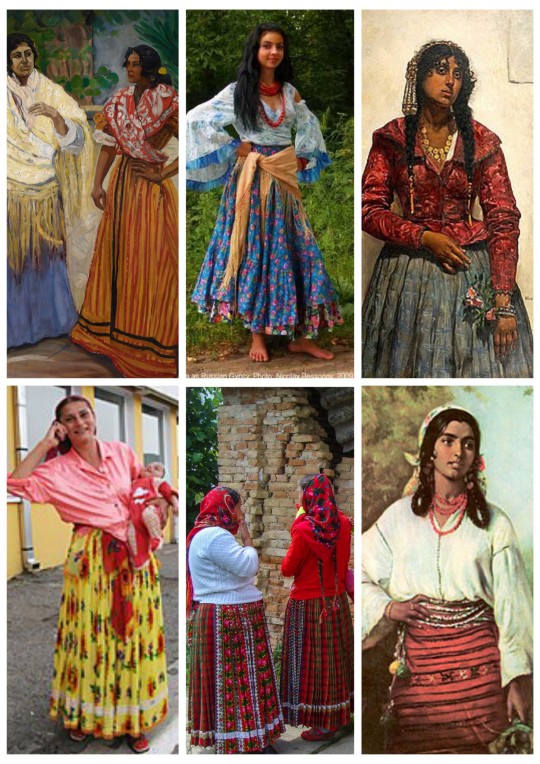
See the difference? Modesty is a huge aspect of Romani culture.
Culture & Society
Again, much of Romani culture is closed and has been kept alive through remaining closed. This is just what they (or scholars) have chosen to tell and what I have personally learned. It is important to remain respectful of what Romani people do and do not want to share. That said, not much is left of Indian influence in Romani culture save for the people who still celebrate Hindu holidays. However, what has survived is the concept of universal balance. Many believe that everything, or almost everything, fits into a natural place. For example, birds are supposed to fly right? It's chill to eat those if your faith allows it. But a penguin? That bitch doesn't fly, it's a freak of nature, so don't eat it. A penguin is out of balance and, therefore, bad luck. That's why Romani people traditionally don't eat hen eggs because girlie can't fly. Of course, other faiths like Muslim Roma, who have special recipes, eat hen eggs.
Like every race, every community and individual has a different faith. Most popular is Christianity and Catholicism and it has become the primary faith among Romani people. Other religions like Islam and Hinduism are also practiced. These faiths have their own set of rules that they follow alongside Romanipen, which is not written and passed down orally. Romani people even have their own patron saints: Ceferino Giménez Malla, The Virgin of Hope of Macarena who is specific to the Spanish Calé, and Kali Sara who is an Indian deity and protector of the Roma. For Christians and Catholics, they also worship the Virgin Mary and Jesus Christ.
Cleanliness is another big facet of Romani culture. Your genital area is considered impure and unclean. Because of this many Roma do not have pet cats or dogs because they lick their genitals. These rules are so strict that food must be entirely discarded should a strand of hair from these animals get into it as the whole meal is then contaminated. Additionally, tops and bottom are typically washed separately as to not mix pure and impure fabrics. This is especially true for AFAB menstruation, which is also seen as impure, as is childbirth. This is because of Romani code which is the most important part of Romanipen: pillars both honor and shame.
Like many societies, importance is placed on the men and subscribe to expected gender norms. In typical Romani home consists of a married couple, their unmarried children, at least one married son and his wife, and their children. Extended family and family in general are an integral part to Romani society so they will play active roles in a Romani child's life. It is possible to be expelled from your community, however, should you go against your community's rules or, for example, marry a gadjo. This is because, depending on the community, it would bring dishonor.
Every since the 16t century, Romani people have either made their livings or enjoyed their time through music and dance. Both still have Indian influences but have also added other elements depending of the region. For example, belly dancing is big among the Turkish Romani. Have you heard of flamenco music from Spain? Did you know that it came directly from the Romani Calé? Romani music has had a huge influence outside of the community, as it has inspired genres like bolero and jazz music.
Before I go onto how I want to see Romani culture integrated with Azusa content in the future, I want to touch up on adoption and interracial marriage. While interracial marriage is frowned upon in some communities, if a gadjo learns Romanipen and lives their life as if they are Romani, they are accepted as fully Romani. This also goes for adopted children. If they live by the rules and codes, dedicate themselves to the culture and society, then they are fully Romani.
Azusa Mukami, His Romani Identity, and What I Want To See More Of
While Diabolik Lovers does have it's problematic moments when referring to Azusa's past such as calling his community but the g-slur, it's super important to recognize how freaking awesome it is to have a Romani character who is largely not a racial caricature and not portrayed as less than simply for being Rom. He is a fully fleshed out and romancable character which is so cool.
It isn't explicitly stated whether Azusa was adopted by his community or is Rom by blood, but given the time period around the 1960's to 1980's (I recommend looking at @i-write-hurt-not-comfort's blog for more information on the Mukami's timeline) I would recommend steering FAR away from the idea of him being picked up since the baby-snatcher stereotype was and is still big. Plus, it's just so much more fun having a non-white Rom love interest. Let him be brown, y'all. Also, he's Romanian Romani, let me see him be Romanian Romani.
Speaking of which, know he's super pale but I want to see him be South Asian and anemic! It's so rare that Romani people are white and Azusa would look cute with tan or dark skin. I'd love to see more art where he has melanin. Brown and black people can be pale too due to things like anemia. Don't be afraid to make him look like a vampire that has not seen the sun in days who happens to be brown!
This man canonically loves spicy food! You know what race's food is super rich in spices and flavor? Romani food! I'd love fics where we get even a throw away line talking about him eating spicy stew or chile mole. Make him hold Ruki at knifepoint in the kitchen having him make some stuffed peppers.
Even small things like him not eating eggs or separating his tops and bottoms because that's what he learned to do as a child would be so damn nice to see. Tiny things that connect him to his race and heritage would be so cool to see in more content of him.
Final Thoughts
Romani people, each community and each individual, have such rich culture and history. They are incredibly interesting to learn about and have had so much influence over things we might not even thing about. They're not only in Europe. They're every where. South America, the US, Asia, every where. It's about time people started recognizing them outside of what governments and white supremacy teaches us and admire the resilience and beauty of the Romani people. Please do your own research and look for real Romani people to get more information from on TikTok, YouTube, hell even the damn bird app. I hope this helped whoever wanted to know more about the Romani people. Thank you sm for reading too, this was a long one.
#ren's essays#romani people#azusa mukami#diaboliklovers#Some of this information may not be fully accurate but I did my best#If you have anything to add please let me know! I love learning new things#This contained a lot of upsetting topics but it's history and that's expected#Thank you to that one person I had fun writing this
69 notes
·
View notes
Text
Irish dress history sources online:
A list of sources for Irish dress history research that free to access on the internet:
Primary and period sources:
Text Sources:
Corpus of Electronic Texts (CELT): a database of historical texts from or about Ireland. Most have both their original text and, where applicable, an English translation. Authors include: Francisco de Cuellar, Luke Gernon, John Dymmok, Thomas Gainsford, Fynes Moryson, Edmund Spenser, Laurent Vital, Tadhg Dall Ó hUiginn
Images:
The Edwin Rae Collection: A collection of photographs of Irish carvings dating 1300-1600 taken by art historian Edwin Rae in the mid-20th c. Includes tomb effigies and other figural art.
National Library of Ireland: Has a nice collection of 18th-20th c. Irish art and photographs. Search their catalog or browse their flickr.
Irish Script on Screen: A collection of scans of medieval Irish manuscripts, including The Book of Ballymote.
The Book of Kells: Scans of the whole thing.
The Image of Irelande, with a Discoverie of Woodkarne by John Derricke published 1581. A piece of anti-Irish propaganda that should be used with caution. Illustrations. Complete text.
Secondary sources:
Irish History from Contemporary Sources (1509-1610) by Constantia Maxwell published 1923. Contains a nice collection of primary source quotes, but it sometimes modernizes the 16th c. English in ways that are detrimental to the accuracy, like changing 'cote' to 'coat'. The original text for many of them can be found on CELT, archive.org, or google books.
An Historical Essay on the Dress of the Ancient and Modern Irish By Joseph Cooper Walker published 1788. Makes admirable use of primary sources, but because of Walker's assumption that Irish dress didn't change for the entirety of the Middle Ages, it is significantly flawed in a lot of its conclusions. Mostly only useful now for historiography. I discussed the images in this book here.
Chapter 18: Dress and Personal Adornment from A Smaller Social History of Ancient Ireland by P. W. Joyce published 1906. Suffers from similar problems to An Historical Essay on the Dress of the Ancient and Modern Irish.
Consumption and Material Culture in Sixteenth-Century Ireland Susan Flavin's 2011 doctoral thesis. A valuable source on the kinds of materials that were available in 16th c Ireland.
A Descriptive Catalogue of the Antiquities in the Museum of the Royal Irish Academy Volumes 1 and 2 by William Wilde, published 1863. Obviously outdated, and some of Wilde's conclusions are wrong, because archaeologists didn't know how to date things in the 19th century, but his descriptions of the individual artifacts are worthwhile. Frustratingly, this is still the best catalog available to the public for the National Museum of Ireland Archaeology. Idk why the NMI doesn't have an online catalog, a lot museums do nowadays.
Volume I: Articles of stone, earthen, vegetable and animal materials; and of copper and bronze
Volume 2: A Descriptive Catalogue of the Antiquities of Gold in the Museum of the Royal Irish Academy
A Horsehair Woven Band from County Antrim, Ireland: Clues to the
Past from a Later Bronze Age Masterwork by Elizabeth Wincott Heckett 1998
Jewellery, art and symbolism in Medieval Irish society by Mary Deevy in Art and Symbolism in Medieval Europe- Papers of the 'Medieval Europe Brugge 1997' Conference (page 77 of PDF)
Looking the part: dress and civic status and ethnicity in early-modern Ireland by Brid McGrath 2018
Irish Mantles, English Nationalism: Apparel and National Identity in Early Modern English and Irish Texts by John R Ziegler 2013
Dress and ornament in early medieval Ireland - exploring the evidence by Maureen Doyle 2014
Dress and accessories in the early Irish tale, ‘The Wooing of Becfhola’ by Niamh Whitfield 2006
A tenth century cloth from Bogstown Co. Meath by Elizabeth Wincott Heckett 2004
Tertiary Sources:
Medieval Ireland: An Encyclopedia edited by Sean Duffy published 2005
Re-Examining the Evidence: A Study of Medieval Irish Women's Dress from 750 to 900 CE by Alexandra McConnell
#resources#dress history#irish dress#irish history#early medieval#bronze age#textile history#late medieval#16th century#historical dress
81 notes
·
View notes
Text
Some readings and resources for further exploration of medieval literature, history, and art
"The Canterbury Tales" by Geoffrey Chaucer
"Beowulf" translated by Seamus Heaney
"The Song of Roland" translated by Dorothy L. Sayers
"The Divine Comedy" by Dante Alighieri
"The Decameron" by Giovanni Boccaccio
"The Book of Margery Kempe" by Margery Kempe
"The Lais of Marie de France" translated by Glyn S. Burgess and Keith Busby
"The History of the Kings of Britain" by Geoffrey of Monmouth
"The Mabinogion" translated by Sioned Davies
"The Romance of Tristan and Iseult" translated by Joseph Bédier
In addition to these literary works, here are some resources for further exploration of medieval history and art:
"A Short History of the Middle Ages" by Barbara H. Rosenwein
"The Civilization of the Middle Ages" by Norman F. Cantor
"The Time Traveler's Guide to Medieval England" by Ian Mortimer
"The Oxford Illustrated History of Medieval Europe" edited by George Holmes
"Medieval Art" by Veronica Sekules
"A Medieval Life : Cecilia Penifader and the world of English peasants before the plague" by Judith Bennett
"The Oxford Handbook of Women and Gender in Medieval Europe" by Judith M. Bennett, Ruth Mazo Karras
The Metropolitan Museum of Art's collection of medieval art and artifacts
The British Library's collection of medieval manuscripts and documents
The Medieval Academy of America's resources and publications on medieval studies
The International Center of Medieval Art's resources and publications on medieval art
These resources should provide a good starting point for further exploration of medieval literature, history, and art.
271 notes
·
View notes
Text

The Mandrake (Mandragora officinarum -also known as Herb of Circe, Wild Lemon, Womandrake) holds the special distinction as being the most famous of all magical plants due to its many ritual and medical uses and the immense amount of mythology it has generated over historical ages.
During the Middle Ages the Mandrake became popular throughout Europe as a magical plant and miracle talisman, capable of curing nearly anything. These roots were thought to be powerful allies who could perform magic for their masters – from attracting love and gaining wealth and good fortune, to warding off misfortunes and evil spells, even to becoming invincible in battle.
The Mandrake was also considered a potent aid to fertility. Historians have determined that the earliest mention of the mandrake refers to its use in Babylon, in the cuneiform tablets of the Assyrians and in the Old Testament as evidenced in chapter 30 of the Book of Genesis where the childless Rachael asks her sister Leah for the loan of the mandrakes which her son had brought in from the fields.It is widely believed that the Old Testament contains multiple references to the ‘love apples’ – the fruits of the mandrake as an aphrodisiac. The first of these instances is again in Genesis, where the scent of the mandrake’s yellow fruits are described as having aphrodisiac properties.
Some evidence exists that the mandrake was used in secret mystical rites in ancient Israel; one of the factors supporting this hypothesis is the significance of the mandrake in Kabbalism as a symbol for ‘becoming One’….
Similarly, in ancient Egypt it appears that mandrake fruits may have been eaten as aphrodisiacs and ancient Greeks also used the mandrake as a sacred love plant.
Ancient Germanic people also often made use of the plant, in particular Germanic Seeresses, who were known for their clairvoyant abilities far outside of Europe, used mandrake regularly as an ally. The modern German name ‘Alraune’ can be traced back to the ancient Germanic term “Alrun”, which translates to ‘all knowing’ or ‘he who knows the runes’…
Mandrake roots have long been used in magic rituals then and still are used today in contemporary pagan traditions such as Wicca and Odinism.
The Mandrake plant is a member of the Nightshade family.The root is hallucinogenic and narcotic. In sufficient quantities, it induces a state of unconsciousness and was used as an anaesthetic for surgery in ancient times. In the past, juice from the finely grated root was applied externally to relieve rheumatic pains. It was also used internally to treat melancholy, convulsions, and mania. When taken internally in large doses, however, it is said to excite delirium and madness.
In the past, mandrake was often made into amulets which were believed to bring good fortune, cure sterility, etc. In one superstition, people who pull up this root will be condemned to hell, and the mandrake root would scream as it was pulled from the ground, killing anyone who heard it. Therefore, in the past, people have tied the roots to the bodies of animals and then used these animals to pull the roots from the soil.
Directions for harvesting a mandrake root in relative safety:
“A furrow must be dug around the root until its lower part is exposed, then a dog is tied to it, after which the person tying the dog must get away. The dog then endeavours to follow him, and so easily pulls up the root, but dies suddenly instead of his master. After this, the root can be handled without fear.”
The following is taken from Jean-Baptiste Pitois’ The History and Practice of Magic:
“Would you like to make a Mandragora, as powerful as the homunculus (little man in a bottle) so praised by Paracelsus? Then find a root of the plant called bryony. Take it out of the ground on a Monday (the day of the moon), a little time after the vernal equinox. Cut off the ends of the root and bury it at night in some country churchyard in a dead man’s grave. For 30 days, water it with cow’s milk in which three bats have been drowned. When the 31st day arrives, take out the root in the middle of the night and dry it in an oven heated with branches of verbena; then wrap it up in a piece of a dead man’s winding-sheet and carry it with you everywhere.”
Mandrake is placed on the mantle to bring prosperity, fertility and happiness to the home, a protector warding off of evil spirits or spells.
Among the old Anglo-Saxon herbals both Mandrake and Periwinkle are endowed with mysterious powers against demoniacal possession. Its human-like forked root was thought to be in the power of dark earth spirits. At the end of a description of the Mandrake in the Herbarium of Apuleius there is this prescription:
‘For witlessness, that is devil sickness or demoniacal possession, take from the body of this said wort mandrake by the weight of three pennies, administer to drink in warm water as he may find most convenient – soon he will be healed.’
It is worn as a talisman or amulet to attract love and repel diseases. As a flying ointment and for its ability to engender shamanic trances.
Mandrake is also said to protect against demonic possession, possibly because it was used by ancient herbalists to sedate manics. To activate a dried root, one must display it prominently in the home for three days, after which it is soaked in water overnight. The water can then be sprinkled on entryways, windows, and people to purify them. The root is now ready for magickal use.
Mandrake
art by Maxine Miller
99 notes
·
View notes
Text
This morning's rehearsal for tonight's performance. On the night of December 24th, the Sybil gives its prophecy.
El Cant de la Sibil·la (The Song of the Sibyl), in L'Alguer called Lo Senyal del Judici (The Sign of the Judgment), is a liturgical drama explained through song where a Sibyl (an Ancient oracle woman) prophetizes and describes the Apocalypse.
In the Middle Ages, this prophecy was performed in different parts of Southern Europe, but the Council of Trent (meeting of the Catholic Church in the years 1545-1563 to unify the Catholic response to Protestantism and its liturgy, bashing heresies) banned it because it considered it a pagan ritual. Somehow, in Mallorca and L'Alguer they continued to represent it, and has survived to this day, still with the original lyrics in Medieval Catalan that were translated from Latin in the 13th century. The most iconic moment comes at the end of the song, when the Sibyl raises her sword to draw a cross in the air.
Since the 19th century, other parts of the Catalan Countries (Catalonia and the Valencian Country) have revitalized the tradition and nowadays it's widely performed in many churches in towns and cities all around the Catalan Countries, like it once was.
In 2010, UNESCO declared Mallorca's El Cant de la Sibil·la Intangible Cultural Heritage of the world.
Video: Catedral de Barcelona.
#cant de la sibil·la#tradicions#nadal#mallorca#illes balears#l'alguer#traditions#cultures#culture#christmas#christmas traditions#ancient#oracle#prophetess#catalan#apocalypse#music#música#arts#gregorian chant
62 notes
·
View notes
Text
"If you take school and university textbooks, which list nations, it is written there that the French were born in the early Middle Ages, the English, the Poles, they all lead from there. And for some reason, we [Ukrainians] need to have origins from the 14th century. The question is, why? Was there any hiatus between the 12th and 15th centuries? No. The population has not changed...
They say, "Tatars used to go here"! The Tatars used to go here, but the Tatars did not sit down here because the Tatars and Mongols needed the steppe. They imposed taxes, and they themselves fled into the steppe.
It should be said that there is no hiatus, which Moscow archaeologists insisted on, and the absence of this hiatus was proven by Soviet archaeology in the 60s and 70s, that there was no depopulation here. Kyiv is an ancient Ukrainian city, just as Kyivan Rus is an ancient Ukrainian state. Why? Because general historical laws. The first stage of European ethnic groups existed - this is the tribal stage. From the 500s to the 900s, about 400 years, all these ethnic groups - the English, the French, the Poles, the Ukrainians, the Serbs - did not have a single ethnonym, they consisted of separate tribal unions. The tribal stage of existence is the entire early Middle Ages. The English consisted of Angles, Saxons, and Jutes. The Poles consisted of five tribes - the Kashubs, the Mazovshans, the Slenzyans, the Vislyans, and the Polyans. And from these tribes five dialects are now left in the Polish language. And the Ukrainians consisted of Polyans, Drevlians, Volhynians, Ulychis, Carpathian Croats... Europe is maturing somewhere in the year 900-1000, and all these peoples are creating their first aristocratic national states. The first English kingdom arises in the year 1000, around this time, the first Polish kingdom of the Piast dynasty arises. At the same time, the Prague principality of the Czechs emerged, at the same time, the Serbian state and Rus, with its centre in Kyiv, emerged. That is, this is a universal regularity. Since all these states that I have listed are considered Polish, English, Serbian or Spanish states in the medieval stage of development in the textbooks of these countries, we have no reason to doubt the Ukrainianness of Rus. Who wants to doubt - please break these universal laws.
You know that Meshko the First lived in the time of Volodymyr the Holy, and his son Boleslav the Brave - in the time of Yaroslav the Wise. So, Meshko the First and Boleslav the Brave are Polish kings, but try to tell someone that Volodymyr the Holy or Yaroslav the Wise are Ukrainians. You will be spit on! Moreover, by the Ukrainians themselves. And, by the way, all the walls of Sophia of Kyiv are covered with Ukrainian texts, Serhiy Vysotsky also spoke about this. Before his death, he called me and told me that there were Ukrainian texts there, but it was impossible to write about it. In the book he published, all this is translated into Russian.
What elements are there on the walls? Наприклад, клична форма української мови – «Петре», «коню», «князю», що питомо українське, в російській мові цього немає. Дієслова на «-ти» – іти, ходити. Дієслова на «-мо» – живемо, ходимо. Давальний відмінок однини чоловічого роду – князеві, Петрові, Іванові.
Vasiliy Klyuchevskii, a great russian patriot, when asked what language the prince of Kyiv spoke, he said: the language that grandmothers speak in the bazaars in Kyiv now. There are a huge number of these proofs in this regard.
Agatangel Krymsky also wrote about these linguistic features. He has an article about what language was spoken in princely Kyiv. He composed a phrase from the words of the 12th century and accompanied it with the following words: no Moscow professor will understand this phrase, and any grandmother from the Kyiv bazaar will. The phrase sounded like this: «Кицька сидить на призьбі, доки її окропом з глека не злякають або хорти лови не влаштують».
So, summing up, princely Kyiv was as much Ukrainian as London was English, Gniezno was Polish, and Paris was French. These were not Ukrainians, Frenchmen, or Poles as they are now. Because it is an organism, and the organism develops. And these were Ukrainians, Poles, and Englishmen at that medieval stage of development."
Leonid Zaliznyak
62 notes
·
View notes
Text
Translating Curse of Darkness' Bios

Hector
24 years old
A Devil Forgemaster, once said to be the strongest among Dracula's subordinates. He lead a normal life, but lost his lover, Rosaly, in a witch trial. He continues his journey alone in order to take revenge on Isaac, the cause of it all.
Isaac
26 years old
A Devil Forgemaster descended from a brilliant family of dark sorcerers. Three years ago, he chased Hector, who betrayed Dracula, but was defeated in battle. Caught in the throes of madness, he wants to plunge Hector into despair and kill him.
(Count) Dracula
approx. 400 years old
He used to be a person full of dignity and pride, but he committed mass genocide against humans, to avenge the loss of his beloved wife happened three years ago. In that battle, he was destroyed by Trevor Belmont.

Julia Laforeze
20 years old
A woman who fled to Wallachia from the Catholic world, where witch-huntings are taking place. She is Isaac's younger sister, and she hopes to save her brother from the insane emotions that rule him. She looks a lot like Hector's former lover Rosaly.
Trevor Belmont
23 years old
A descendant of the Belmont family, a legitimate lineage of vampire hunters. Three years ago, he destroyed Dracula with the help of his friends. He has come back to Wallachia, after hearing that the Devil Forgemasters are behind a disturbing development.
Zead
Age unknown
A mysterious man who wears a black clergyman-style outfit that covers his whole body. He has set foot into Wallachia to break the Dracula curse that has spread across Europe. He is concerned about the presence of Isaac, who is trying to protect the curse.
Saint Germain
Age unknown
A man with a eccentric appearance that doesn't exist in the Middle Ages, and a master at talking while hiding his true intentions. He intends to stop Hector from chasing Isaac. His motives are a mystery, but he describes himself as an "all-knowing" being.
#castlevania#curse of darkness#hector castlevania#isaac laforeze#dracula castlevania#julia laforeze#trevor belmont#zead#saint germain#far juicier than loi's bios#so this confirms that lisa was killed shortly before the events of c3#interesting#but the most important tidbit of information for me is of course#isaac is a dark witchy boy <3
137 notes
·
View notes
Text
It's time again for a round of "Are they brothers or aren't they brothers?"
Kaeluc Antis never tire of accusing shippers of shipping an incestuous ship. And that's why I would like to write a little about it.
1. At least in Germany you can't just adopt a child. Qoute:
To be able to adopt a child, the biological parents must have consented to the adoption. It is irrelevant how the parents relate to each other. The consent must come from both parents. For example, in the case of stepchild adoption, the permission of the parent who does not continue to care for the child must be given.
Source
Diluc's father couldn't have adopted Kaeya, because Kaeya's father never agreed to it. And I take extra German guidelines, because Mondstadt is modeled after Germany. Especially because Keaya would then have taken the Ragnvindrs' family name and would no longer be called Alberich.
2. What are sworn brothers. Qoute:
In the European Middle Ages and early modern times, oath brotherhood (Latin fraternitas iurata) referred to an artificial kinship relationship between two friends, which was often sealed through ritual acts, including within the church. These rituals could include mixing or exchanging the blood through drinking (blood brotherhood). For a cross-cultural order, see Brother (friendship). Since the publication of the book Same-Sex Unions in Premodern Europe by the historian John Boswell, there has been a discussion in history, in the lesbian and gay movement, but also in the various churches about the extent to which this institution can be seen as proof that Christianity is same-sex is connections in the past are not only acknowledged but also acknowledged.
However, John Boswell's claim (see below) that sworn brotherhoods were legitimized as same-sex partnerships (i.e. including genital acts) accepted by the Orthodox Church in the form of adelphopoiesis is not tenable. The original purpose of adelphopoiesis was to establish a spiritual kinship (as in a baptismal sponsorship) (see below).[2] However, contrary to the claims of Boswell's critics to the contrary, the oath brotherhood must actually have been used by same-sex couples. This is proven by Orthodox canon law, which justifies the abolition of adelphopoiesis in Eastern Roman law and in the ecclesiastical canons with the fact that the oath brotherhood had been abused for the “fulfillment of carnal lusts and sensual passions”.[3]
Source
So we are talking about a spiritual brotherhood/family and not an adoptive or kinship. Otto Apocalypse from Honkai Impact also says that Welt can join his family by becoming Otto's sworn brother. In this case, it may even be right, if Kaeya actually calls Diluc his brother and Crepus his father.

3. Can I marry my Stepsilbing. Qoute:
According to Section 1308 Paragraph 1 Sentence 1 BGB, a marriage should not be concluded between people whose relationship within the meaning of Section 1307 BGB has been established through adoption. This does not apply if the acceptance relationship has been terminated. Otherwise, adoptive siblings can only marry each other with the approval of the family court (Section 1308 Paragraph 2 BGB). However, the effectiveness of a marriage concluded contrary to this provision is not affected. It cannot be repealed because this case is not mentioned in Section 1314 of the German Civil Code (BGB).
Source
So yes. Keaya could marry Diluc, if he would break the relationship with Diluc and his father. So. If Kaeya had been adopted. Which he isn't.

And even the Webtoon Artist of the official Genshin Impact Webcomics shipped them togehter:


No matter how you turn it and turn it, there is still a translation error. Diluc and Kaeya are not adopted brothers, but sworn brothers. Deal with it.

38 notes
·
View notes
Text
christianity
orthodoxy (chesterton) HC
everlasting man (chesterton) PB
europe and the faith (belloc) HC (this one’s nice)
the restitution of man (aeschliman/lewis) PB
the germanization of early medieval christianity (russell) PB
middle ages & art
life on the english manor 1150-1400 (bennett) HC
life on the english manor 1150-1400 (bennett) (cooler copy) HC
the autumn of the middle ages (huizinga) (best translation) HC
social theories of the middle ages (some catholic clergyman) HC
medieval art (stokstad) PB
a book of hours HC (tiny, lots of full colour reprints)
image on the edge (some pomo bitch) HC
guilds in the middle ages (renard) HC
the book of beasts (some little cheesy glossary of medieval beasts according to the latin bestiaries) PB
race & politic’s
the works of joseph de maistre this ones a keeper
couple antebellum pro-slavery books HC
the rising tide of color (stoddard) HC, ‘20s edition i think, with original dustcover
race or mongrel (schultz) HC, another early 20th cent book about white people being better than brown people
the dispossessed majority (allen) HC, this one’s boring as fuck
nation and race PB (i don’t even know what this one is, bunch of essays about the scary rise of the scary new right wing in europe or something, who cares
black hundred (some russian commie) HC, book about history of russian right wing and anti-communism
nations and nationalism since 1780 (hobsbawm, dead jewish commie) PB
the meaning of conservatism (scruton) HC
what the social classes owe each other (sumner) PB this one sucks
readings on fascism and national socialsm PB
varieties of fascism (krieger) PB
ride the tiger (evola) HC
the k's
j5ws and modern capitalism (sombert) PB
j5w'sh eugenics (john glad) HC
culture of critique (macdonald) PB
other
basic writings of nietzsche HC
zarathustra’s discourses (some tiny penguin PB with excerpts from TSZ)
solitude (storr) PB here’s one for the introverts
the book of five rings (miyamoto musashi) tiny PB
letters to a young contrarian (hitchens) (yes, christopher) (don’t ask) HC
11 notes
·
View notes